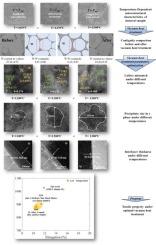Vacuum heat treatment induced excellent low-temperature tensile performance of EAM fabricated 96 W alloys
IF 4.6
2区 材料科学
Q2 MATERIALS SCIENCE, MULTIDISCIPLINARY
International Journal of Refractory Metals & Hard Materials
Pub Date : 2025-09-08
DOI:10.1016/j.ijrmhm.2025.107432
引用次数: 0
Abstract
To address the low-temperature performance degradation of tungsten heavy alloys fabricated by extrusion-based additive manufacturing (EAM) process with hydrogen sintering, the vacuum heat treatment was utilized to improve the low-temperature tensile properties of 96 W alloy in this study. The DSC, XRD, SEM, TEM, EBSD were adopted to analyze the thermophysical properties, phase composition, microstructure morphology and lattice mismatch of 96 W-2.8Ni-1.2Fe alloys under different sintering and vacuum heat treatment parameters. Based on the optimized sintering parameters induced high-tensile-performance 96 W alloys, this study investigated their low-temperature performance degradation and low-temperature performance strengthening via vacuum heat treatment under different holding time and temperature. Surprisingly, the hydrogen content change after vacuum heat treatment was found to be inconspicuous, and the results showed that vacuum heat treatment benefited γ phase infiltration at W![]() W interfaces, relieved residual stress from thermal expansion difference, altered W/γ interface structure (lattice mismatch and interface layer thickness) and precipitate size, and promoted nano-twin nucleation. Under optimal vacuum heat treatment parameter 1200 °C-60 min, the low-temperature (−30 °C) tensile strength and elongation of 96 W alloy were 1027 ± 15 MPa and 11.9 ± 1.0 %, which is even superior to the 92 W ∼ 93 W alloys with more ductile phases. These findings distinguish this study from similar researches about tungsten heavy alloys, and make it instructive for the application of EAM and powder metallurgy fabricated tungsten heavy alloys under low-temperature environments.
W interfaces, relieved residual stress from thermal expansion difference, altered W/γ interface structure (lattice mismatch and interface layer thickness) and precipitate size, and promoted nano-twin nucleation. Under optimal vacuum heat treatment parameter 1200 °C-60 min, the low-temperature (−30 °C) tensile strength and elongation of 96 W alloy were 1027 ± 15 MPa and 11.9 ± 1.0 %, which is even superior to the 92 W ∼ 93 W alloys with more ductile phases. These findings distinguish this study from similar researches about tungsten heavy alloys, and make it instructive for the application of EAM and powder metallurgy fabricated tungsten heavy alloys under low-temperature environments.

真空热处理使EAM制备的96w合金具有优异的低温拉伸性能
针对氢烧结挤压增材制造(EAM)工艺制备的重钨合金低温性能下降的问题,采用真空热处理技术改善96 W合金的低温拉伸性能。采用DSC、XRD、SEM、TEM、EBSD等分析了96种W-2.8Ni-1.2Fe合金在不同烧结和真空热处理参数下的热物理性能、相组成、显微组织形貌和晶格失配。以优化的烧结工艺为基础,研究了96 W合金在不同保温时间和保温温度下的低温性能退化和低温性能强化。结果表明,真空热处理有利于W/γ界面γ相的浸润,减轻了热膨胀差造成的残余应力,改变了W/γ界面结构(晶格失配、界面层厚度)和析出相尺寸,促进了纳米孪晶的成核。在最佳真空热处理参数1200℃~ 60 min下,96 W合金的低温(- 30℃)抗拉强度和伸长率分别为1027±15 MPa和11.9±1.0%,甚至优于具有更多韧性相的92 W ~ 93 W合金。这些研究结果与同类重钨合金的研究结果有所区别,对EAM和粉末冶金制备的重钨合金在低温环境下的应用具有指导意义。
本文章由计算机程序翻译,如有差异,请以英文原文为准。
求助全文
约1分钟内获得全文
求助全文
来源期刊
CiteScore
7.00
自引率
13.90%
发文量
236
审稿时长
35 days
期刊介绍:
The International Journal of Refractory Metals and Hard Materials (IJRMHM) publishes original research articles concerned with all aspects of refractory metals and hard materials. Refractory metals are defined as metals with melting points higher than 1800 °C. These are tungsten, molybdenum, chromium, tantalum, niobium, hafnium, and rhenium, as well as many compounds and alloys based thereupon. Hard materials that are included in the scope of this journal are defined as materials with hardness values higher than 1000 kg/mm2, primarily intended for applications as manufacturing tools or wear resistant components in mechanical systems. Thus they encompass carbides, nitrides and borides of metals, and related compounds. A special focus of this journal is put on the family of hardmetals, which is also known as cemented tungsten carbide, and cermets which are based on titanium carbide and carbonitrides with or without a metal binder. Ceramics and superhard materials including diamond and cubic boron nitride may also be accepted provided the subject material is presented as hard materials as defined above.

 求助内容:
求助内容: 应助结果提醒方式:
应助结果提醒方式:


